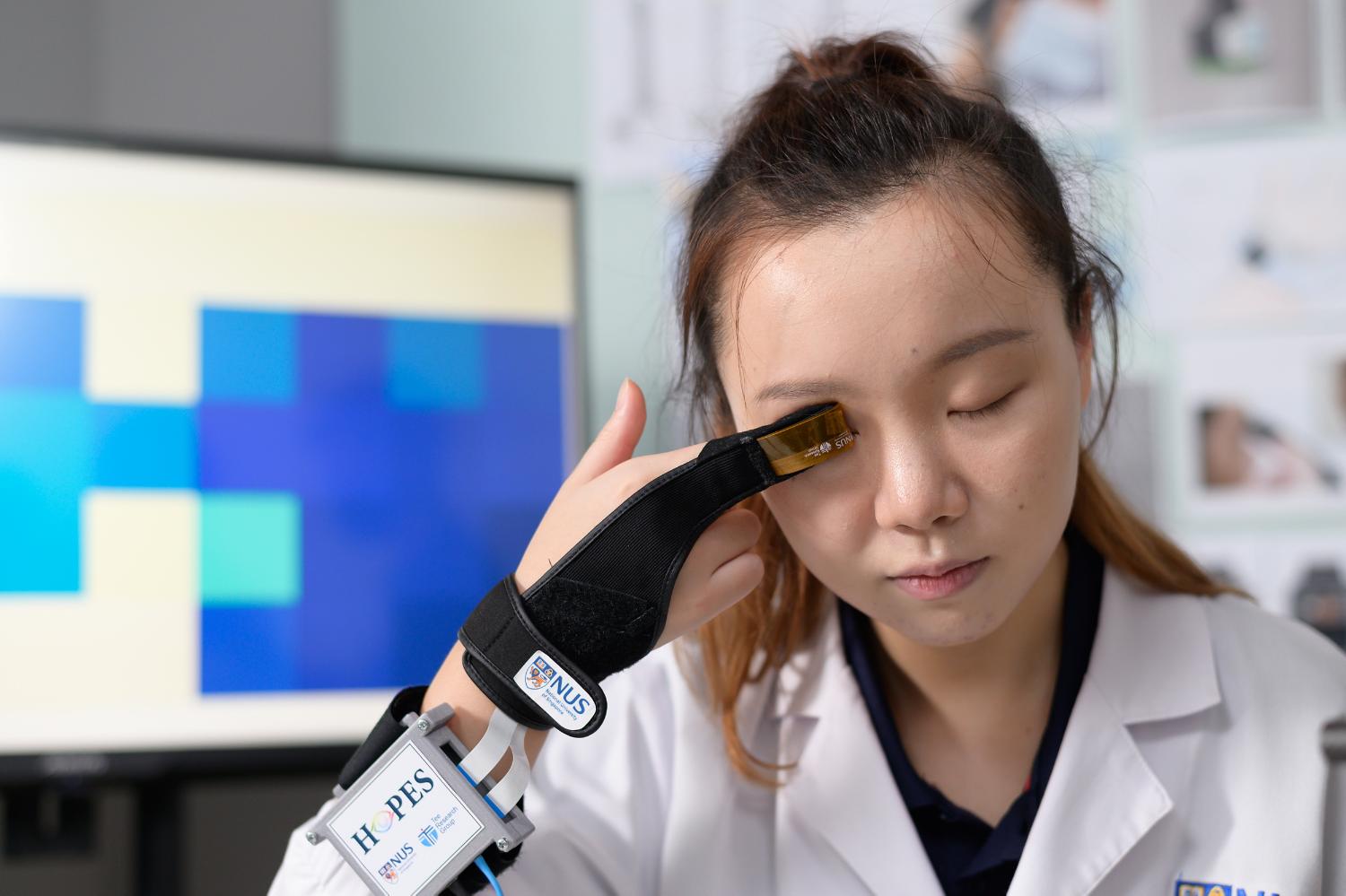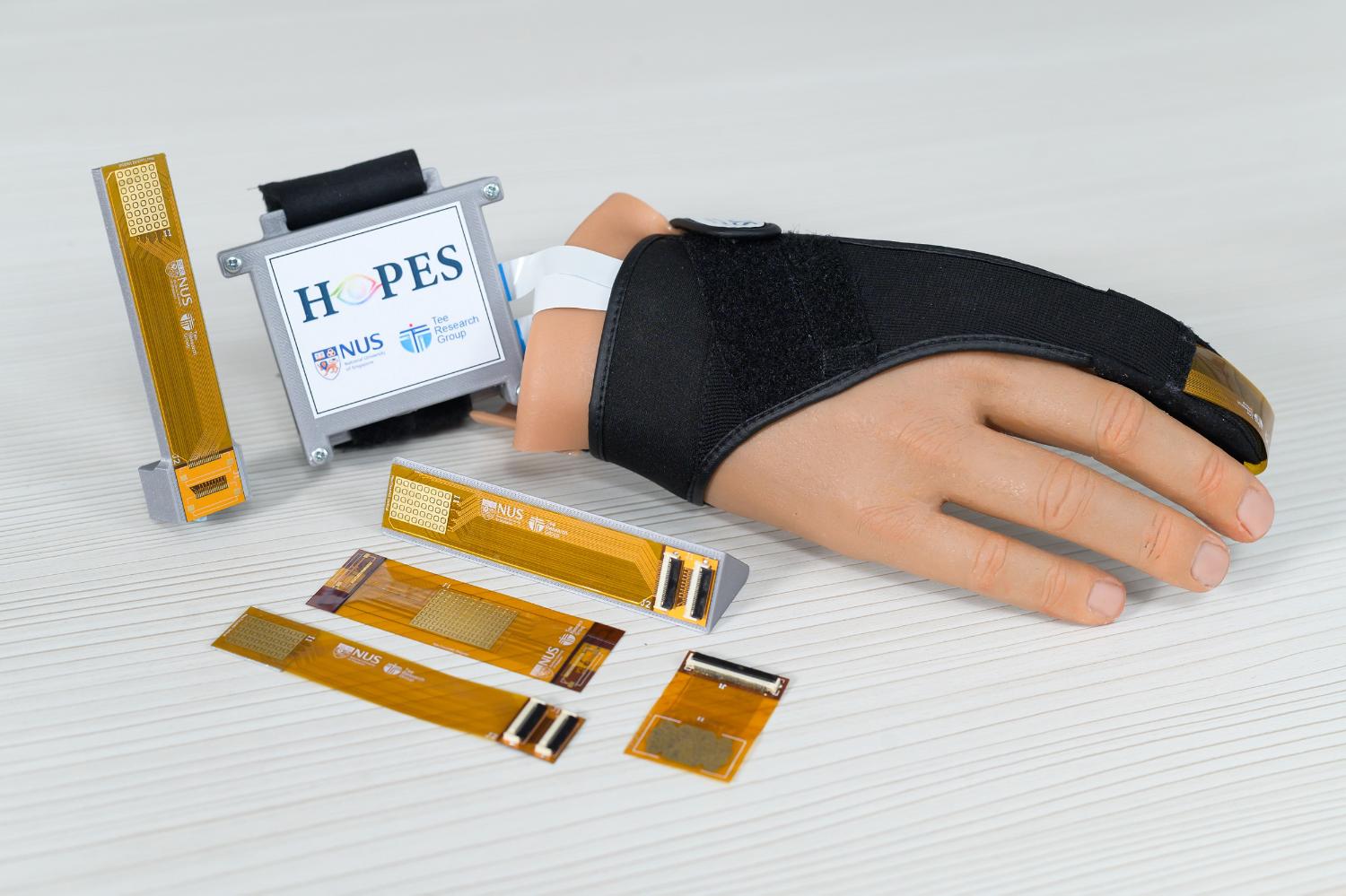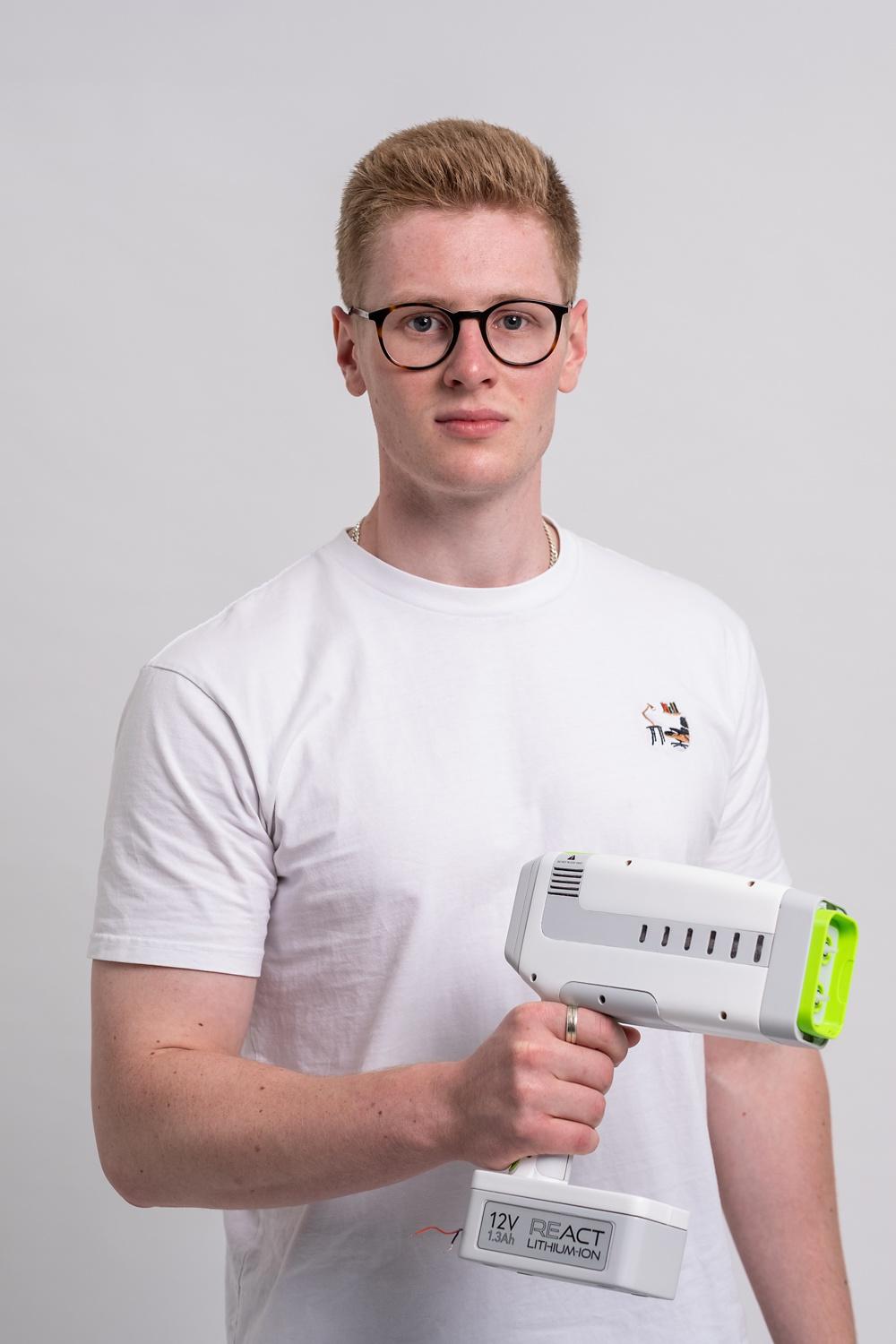.png?$responsive$)
James Dyson Award 2021: Three global winners with world-improving inventions
INTERNATIONAL WINNER
HOPES, A device for pain-free, at-home eye pressure testing, opening up access to glaucoma testing, by students of the National University of Singapore.
SUSTAINABILITY WINNER
PLASTIC SCANNER, A low-cost, handheld device to identify plastic for recycling, by Jerry de Vos from TU Delft.
MEDICAL WINNER
REACT, A technology to stem bleeding to help save the lives of stabbing victims, by Joseph Bentley from Loughborough University.
The James Dyson Award has supported nearly 300 promising inventions from young engineers and scientists in 28 countries around the world. In 2021, the Award received a record number of entries worldwide and Sir James Dyson chose three global winners for the first time, each receiving $40,000 in prize money to support the next stages of their inventions.
-
“I enjoy seeing the enthusiasm with which young people tackle the world’s problems using good design, engineering and science. So promising were this year’s entries that we’ve awarded a third prize, focused on medical invention. Commercializing an idea is very hard – I hope that the awareness that the Award drives, as well as the financial support it provides, will give these ideas a springboard to success.”
- Sir James Dyson, Founder and Chief Engineer at Dyson.
The winning inventions
International winner - HOPES
Designed by Kelu Yu, Si Li and David Lee
National University of Singapore
-
The problem
This year’s International winner of the James Dyson Award was inspired by one of the inventors’, Kelu, father’s diagnosis of glaucoma. After witnessing his discomfort and multiple hospital visits, she realised there is a global need for a less invasive and more accessible method for Intraocular Pressure (IOP) monitoring. Glaucoma is the second leading cause of blindness worldwide.
In 2020, about 80 million people have glaucoma worldwide, and this is expected to rise to over 111 million by 2040. Because it is largely symptom-free, it’s also known as the “silent thief of sight”. There is no cure but, if diagnosed and treated early, blindness can be prevented.
Today, regular IOP monitoring is a critical tool in helping clinicians determine long-term treatment plans and goals. This is achieved through the Goldmann Applanation Tonometry – regarded as the gold standard for the measurement of IOP. There is a demand for safe, accurate, low-cost, at-home IOP measurement devices to better improve the patient experience.
-

-
The solution
HOPES, (which stands for Home eye Pressure E-skin Sensor) is a wearable biomedical device for pain-free, low cost, at-home IOP testing. Powered by patent pending sensor technology and artificial intelligence, HOPES is a convenient device for users to frequently self-monitor IOP.
After creating a profile in the App, the user wears the HOPES glove with the sensor placed at the fingertip, pressing this against the centre of the eyelid. The fingertip employs a unique sensor architecture that captures dynamic pressure information of the user's eye with sub-millisecond precision. The captured signals are processed by machine learning algorithms to continuously and accurately compute users’ IOP.
Data is transmitted via Bluetooth to paired devices or uploaded to the Cloud to be accessed remotely by clinicians. The App prompts users with easy-to-read measurement history and direct links to healthcare systems, allowing them to seek medical help to minimize future symptoms.
-

-
Next steps
The team plan to collaborate with clinicians at the National University Hospital to collect and analyze patients’ eye pressure data to train the device’s machine learning mode. At the same time, they are working on optimizing HOPES’ performance, and improving its design.
-
“We were thrilled to hear from Sir James Dyson that we are this year’s International winners of the James Dyson Award. For us this all started with Kelu and her attempt to create a solution for her father after the problem they faced as a family. With this win, we hope in the future people can measure their eye pressure in a pain-free, at-home environment. We want to improve people’s quality of life and aspire to one day apply our research group’s sensor technology across different health monitoring applications, such as robotics and biomedical devices.”
- HOPES team.
-
“I’ve experienced first-hand how invasive and unpleasant the tests for glaucoma can be, but it is a vital test. This group of young people have tackled a problem that doesn’t affect them directly, but which affects members of their family. Their work has the potential to make glaucoma testing much more widely available and I wish them every success as they navigate the challenging process of further development and medical approvals.”
- James Dyson, Founder and Chief Engineer at Dyson.
Sustainability winner - Plastic Scanner
Designed by Jerry de Vos
TU Delft, Netherlands
-
The problem
Plastic is a lightweight, safe and readily available material which can be used to make long-lasting, durable products. It has a bad reputation because it is often not thought to be recyclable and so ends up in landfill, or worse on the beach or in our oceans. However, with the right technologies plastics can be widely recycled successfully at end of life and transformed into new products, which themselves are long-lasting and durable.
The challenge is identifying the plastic so that it can be recycled in the correct way, rather than sent to landfill. The technology exists but is expensive and rare. With greater availability of plastic identification much more plastic can be recycled and therefore used more effectively.
-
.jpg?$responsive$&cropPathE=desktop&fit=stretch,1&fmt=pjpeg&wid=960)
-
The solution
The Plastic Scanner, invented by Industrial and Product Design graduate Jerry De Vos from the Netherlands, is this year’s Sustainability winner. Plastic Scanner is a handheld device that when held against plastic will tell the user what materials it’s made from. It uses near-infrared spectroscopy, a technology that can categorize more than 75% of plastics.
Jerry is a member of Precious Plastic, an organization that aims to reduce plastic waste. Through his work for the organization he has witnessed the negative impact of plastic pollution first-hand and the bottlenecks caused when plastic is not identified and sorted in the recycling process. Around the world, much of this process is done by hand which takes time and is prone to error. Jerry has seen successful technology used in large factories in the Netherlands where infrared reflections assist with the sorting. This is a vital step for ensuring it is recycled properly. Jerry’s mission has been to make this technology available for everyone around the world so they can recycle better.
The Plastic Scanner uses near-infrared spectroscopy to detect types of plastic – a new and low-cost approach to traditional infrared spectroscopy. The Scanner also uses the open source GPL-v3 license, so anyone can assemble the breakout board and embed the electronics into a handheld device. Open source welcomes feedback and improvements from experts, so the project will continuously improve as more people recycle plastic around the world.
Jerry builds upon Armin Straller's ReReMeter project (the design Jerry used as a starting point), by applying the technology in a portable form. This design was the basis for Jerry to eventually make the Plastic Scanner into a tangible product by continually developing and improving it with, for example, a mini-computer, battery, screen, button and the housing of the final prototype.
Jerry learnt that much plastic entering our oceans comes from low and middle-income countries. It is his mission to support recycling initiatives in these nations with the way he designed the low-cost and ease of use of the Plastic Scanner. During development, Jerry interviewed recyclers from India, Indonesia, Kenya and Curacao to ensure his model was suitable for end users.
-
.jpg?$responsive$&cropPathE=desktop&fit=stretch,1&fmt=pjpeg&wid=960)
-
Next steps
Jerry has gathered a team of friends specializing in embedded systems and machine learning to support his creation of new prototypes and pilot the Scanner in both industry and low resource contexts. Long-term his goal is to make the project sustain itself, with DIY versions of the Scanner, whilst enriching Open-source documentation to make it easier for others to get involved and contribute to his mission.
-
“When James Dyson personally told me that I had won the Sustainability prize, I was stunned and then started to realize the impact of this win and the possibilities the Award generates. The goal of the Plastic Scanner is to build a simple, open-source device that can identify the most common types of plastic. I am so motivated after winning the James Dyson Award and it will help accelerate the development process on both the electronics, as well as the software side of the invention. By improving its quality and making it intuitive to replicate, I hope to enable anyone to identify and sort plastic properly, overcoming one of the most complex barriers to recycle plastic anywhere around the world.”
- Jerry de Vos.
-
“It may be fashionable to demonize plastic but it is a durable and versatile material which has an important role to play. The challenge, of course, is ensuring it is reused and recycled effectively to avoid it going to landfill. Understanding how to recycle plastics correctly is complicated but Jerry has developed a very effective technology that could put this knowledge into everyone’s hands. Jerry is focusing his efforts on supporting developing countries. When I rang Jerry to deliver the news, he was travelling to Algeria to help local communities deploy recycling initiatives, his is inspiring work and I wish him every success with this potentially significant technology.”
- James Dyson, Founder and Chief Engineer at Dyson.
Medical winner - REACT
Designed by Joseph Bentley
Loughborough University, UK
-
The problem
Knife crime is an issue in many countries around the world and last year, with rates of knife crime on the rise in almost all continents, particularly in countries with strict gun laws. In England and Wales alone, there were around 46,000 offences involving a knife or sharp instrument, which is the highest number of offences since the year ending March 2011.
The average wait time for an ambulance in the UK is currently just over eight minutes, yet it can only take five minutes for someone to bleed to death.
-

-
The solution
The REACT device (which stands for Rapid Emergency Actuating Tamponade) aims to reduce catastrophic blood loss from a knife wound. The current advice for treating stab wounds is to never remove the knife object from the wound if it is still in place. This is because the object is applying internal pressure to the wound site whilst also filling the cavity and preventing internal bleeding. Joseph’s concept is based on the same principle, the implantable medical-grade silicone balloon tamponade would be inserted into the wound tract by a first responder. The actuator device is connected to the tamponade valve, and the user selects the wound location on the device interface. Squeezing the trigger on the actuator starts the automated inflation sequence, and the tamponade is inflated to a defined pressure based on the wound location to try and stem the bleeding.
During the early research and development phases, Joseph discovered that current wound management techniques like wound packing are sometimes used by paramedics to prevent bleeding from stab wounds. This process involves tightly packing a wound with gauze, which will help to apply pressure internally to the site. According to Joseph, the process can be slow, technical, and extremely painful to the victim, but has in many cases proven to be successful in quickly stopping bleeding from knife wounds.
Despite this, the technique may not be suitable for wounds in cavities like the abdomen, which is the most common area for knife wounds to appear following a knife attack. During his prototyping, Joseph found that the simple application and automated inflation procedure of the REACT system could be a more effective method for first responders compared to traditional methods. He claims his prototype Tamponade could potentially be in place and stopping haemorrhage in under a minute, which Joseph estimates could save hundreds of lives a year.
-
Next steps
Winning a global James Dyson Award prize will inject a further $40,000 into Joseph’s project. He aims to commercialize his invention in the coming years, using the Award money for further research and official medical testing into how the REACT invention can become a global solution to knife wounds and hopefully save lives.
-
.png?$responsive$&cropPathE=desktop&fit=stretch,1&fmt=pjpeg&wid=960)
-
“I am beyond words in describing my gratitude in receiving this global prize dedicated to a medical innovation. Knife crime is horrific and a global challenge that is claiming the lives of thousands every year. The REACT system has the potential to be a life-saving tool in the fight against knife-crime, but the development of medical devices is a long and challenging process. The recognition and funding provided by the James Dyson Award has given me the determination and confidence to develop the REACT system and getting it into the hands of first responders as soon as possible.”
- Joseph Bentley.
-
“This type of problem solving invention shows the significant impact engineers can have on serious, global issues, and is why I created the James Dyson Award. Developing a medical device is very challenging and there will be no end of hurdles, but I would urge Joseph not to be put off since the opportunity to save lives is so great. I hope that through winning the Award this invention gets the support it requires as it has the potential to make an impactful change.”
- James Dyson, Founder and Chief Engineer at Dyson.
The Dyson Institute of Engineering and Technology, the James Dyson Foundation and James Dyson Award encourage aspiring engineers to apply their knowledge and discover new ways to improve lives through technology. Since the competition first opened in 2005, James and the James Dyson Foundation have donated over $180m to boundary-breaking concepts in education, medical research and other charitable causes. The Award has supported nearly 300 inventions with prize money to date.
Press contacts
Canada
Email us at CAN.PR@dyson.com
Social media
Twitter: @askdyson
YouTube: youtube.com/Dyson
Facebook: facebook.com/dyson
Instagram: @dyson, @dysonbeauty
LinkedIn: Dyson
Discover Dyson




.jpg?$responsive$)
.jpg?$responsive$)

.png?$responsive$)